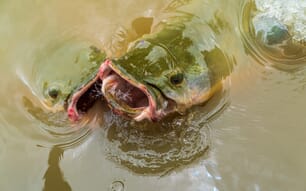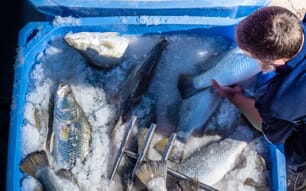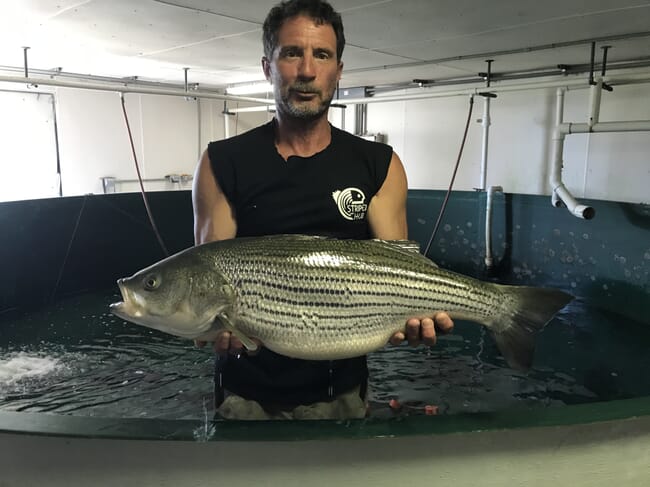
This is a tale of the application of two basic genetic improvement strategies to the striped bass (Morone saxatilis): hybridisation and selection. Historically esteemed and economically important, the species makes a visual impression rivalled only by its flavour and reputation as a sportfish. With a natural range along the Atlantic and Gulf coasts of North America, striped bass are anadromous by nature, favouring saltwater habitats as adults, migrating to freshwater to spawn in the spring and returning to the sea after spawning. The young spend their first 6 to 12 months in freshwater and brackish habitats before moving downstream to saltwater. Notably, some self-sustaining populations can also be found in inland freshwater environments.
The history
Following decades of mismanagement and habitat degradation, commercial landings of striped bass along the east coast of the US plummeted to almost nothing in the 1970s and 80s. In addition to widespread fishery closures, efforts to help stocks rebound included releases of fry and fingerlings from state and federal hatcheries. Although striped bass had already proven to be poorly suited for culture in early trials, these activities sparked renewed interest in the topic. Several smaller North American species of Morone were also considered at that time for their aquaculture potential, the most common of which is the white bass (M. chrysops), a hardy fish found throughout much of the Mississippi River watershed. In a number of hatcheries throughout the US, hybrids between striped and white bass were found to be hardy and to exhibit good growth and survival in pond culture.
Hybrids produced from striped bass females and white bass males, commonly called palmetto bass, had already been created in 1965 in South Carolina, and had occasionally been stocked into public waters for recreational sport-fishing purposes. The reciprocal cross, widely produced by the early 1990s, is generally referred to as sunshine bass. This fish was the key factor in the expansion of commercial culture of hybrid striped bass, due to the comparative ease of collecting and maintaining female white bass in a hatchery setting.
Farming protocols
Hybrid striped bass larvae are reared in fertilised ponds with natural zooplankton. Typically, after three weeks they are weaned to artificial feed and then restocked in ponds until they reach 125 -225 g. Then, they are graded for final grow-out to sizes of 600 to 1,100 grams, over a two-year cycle. High protein floating feeds are used, and aeration is required for profitable production. Some markets demand a 1,500 g fish, requiring lower pond densities or intensive tank production, but maintaining profitability becomes more challenging for producers under these scenarios. Most production is in freshwater, but hybrids also perform well in low salinity environments. Fingerling production over recent decades has largely relied on collection of wild fish during annual spawning runs, but hatchery operators are increasingly focusing on maintaining and re-using broodstock.
A major drawback in hybrid striped bass aquaculture involves maturation and gonadal development at approximately 2 years of age. At this time, between 650 and 700 g, growth and feed efficiency decline sharply. By this point these fish have already reached an acceptable size for some markets, but other markets, especially those historically focused on pure striped bass, demand a larger fish. Induction of triploidy has been evaluated as a possible remedy for this production constraint, but with mixed results. Selection within pure line breeding stocks has also been considered, but this entails long term maintenance of pure parental species and results are not always predictable. Other problems plague the industry: hybrids exhibit little, if any, growth at water temperatures below 15° C and experience stress and disease at high temperatures. Snail- and bird-related parasites can be problematic in pond production due to comparatively low stocking densities. Lower feed inputs increase visibility in the water column, resulting in more aquatic vegetation and therefor more habitat for snails.
Nevertheless, there has been significant demand for hybrid fry from a number of countries for many years – primarily Israel, Italy and several Asian nations. Some growers in these countries are working to develop their own broodstock, but this involves acquiring and maintaining pure lines. Although efforts to produce F2 hybrids have occurred over the years, they are not suitable for production, and trials have been limited in scope. Nonetheless, some F2 fish are clearly robust, confirming the potential for a more long term approach to broodstock development.
In domestic markets, growers have steadily climbed the hybrid learning curve to a point where production is largely predictable and profitable. I asked Paul Zajicek, executive director of the US National Aquaculture Association, for his views on the country’s hybrid striped bass industry.
As he explained: “Across the US the fish are pond-raised and are absolutely stunning in their appearance. The sales are as iced, whole fish or live fish, so the market is limited by the number of buyers that really appreciate fresh, high-quality fish (high-end restaurants and retailers). Not a high-volume typical American market.
“One of the largest farms (Texas and Mississippi locations) in the US was sold but their Mississippi farm did not sell. Over a month, the owner sold off the inventory and equipment and released his employees. The other farms in the US geared up to fill the market gap. To me it appears the market is steady, maybe with slight growth, and with prices that support the farms that are producing the fish. Although, with the shakeup in US seafood production, buyers may be looking for new sources of product.”
The recreational fishery market for hybrid striped bass throughout the US continues to grow as well. There are millions of inland ponds throughout the continental US, and these fish have become an increasingly popular option for stocking as a result of their rapid growth and acceptance of pelleted feeds.
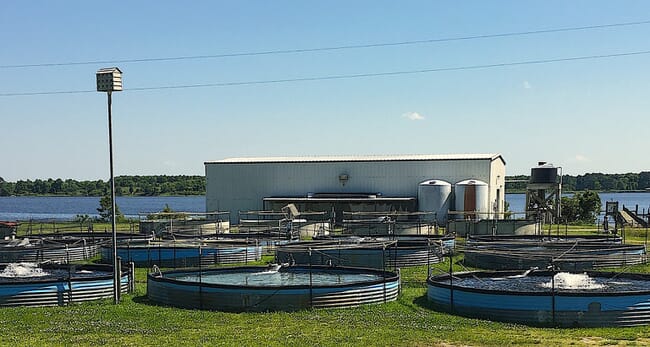
PAFL has been selectively breeding striped bass for three decades
Genetic selection
The need for hybridisation to produce stocks that are sufficiently hardy for profitable culture may soon be a moot point if efforts to develop superior lines of domesticated striped bass continue to advance. For several decades, researchers in North Carolina have been involved in collaborative work to overcome constraints to commercial production of pure striped bass through a long-term selection programme. As a result of these advances, and techniques developed to spawn the fish naturally and without hormones, many members of the striped bass research community believe commercial production is just around the corner.
One of these believers is my former graduate student Eric Herbst, who is currently North Carolina Sea Grant’s coastal aquaculture specialist. Herbst gives most of the credit for advances in striped bass domestication and genetic improvement to North Carolina State University’s Ben Reading and his predecessors. Reading serves as the director of the Pamlico Aquaculture Field Laboratory (PAFL). Over the past 30 years, PAFL has been home to ongoing efforts to selectively breed striped bass for improved growth, stress tolerance, disease resistance and optimised feed efficiency.
The ongoing work at PAFL and collaborating institutions eventually led to what is known today as StriperHub. This is a network led by North Carolina Sea Grant and North Carolina State University. The network was awarded funding in 2019 to facilitate striped bass aquaculture in the US by overcoming barriers to industry development and expansion. StriperHub has officially been active since 2020, with research and demonstration activities focused on commercial-scale culture methods, economic analyses, and market evaluations. In late 2022, the National Oceanic and Atmospheric Administration recognised this important work by awarding StriperHub $1.4 million.
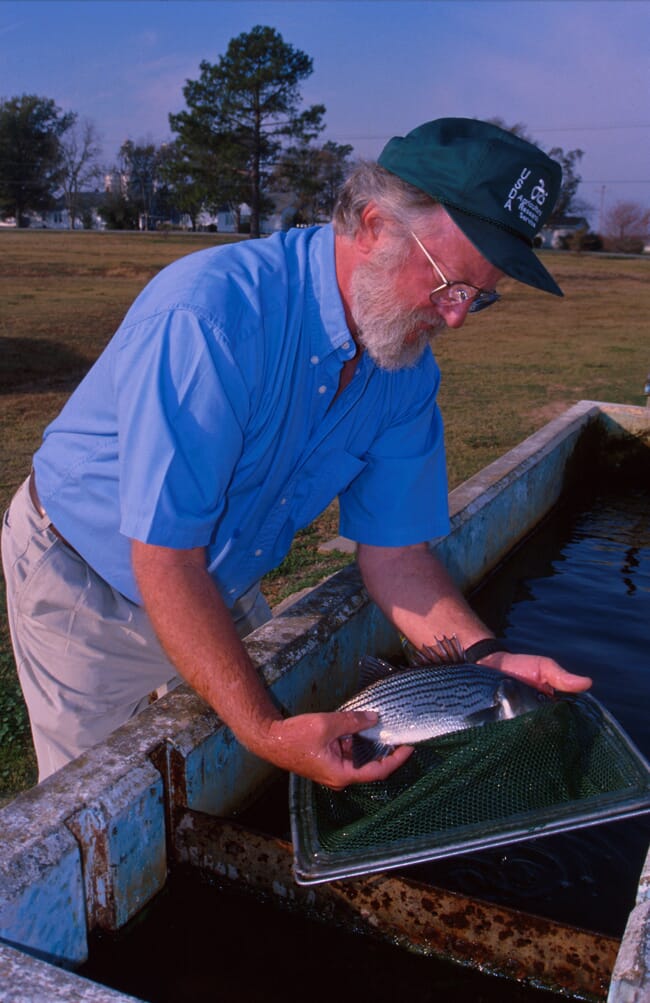
© USDA-ARS
Last month, Herbst provided an update on the current status of striped bass culture and related StriperHub activities. In terms of growth performance of domesticated stocks, he stated it is now possible to raise these fish to 1.8 kg in 18 months in RAS facilities.
“We see an 11-15 percent increase in growth rate every generation, and F8 fish are being produced at this time,” he added.
He also cited significant improvements in disease resistance, stress tolerance (including stress resulting from thermal extremes, handling and water quality issues), feed efficiency and captive spawning.
When asked about the selection programme and its origins, he explained: “Genetic bottlenecking was prevented with creation of a master stock roughly 30 years ago. That captive population incorporated the genetics of fish from the St Lawrence River in Canada with just about every stock along the eastern US seaboard, down to the St John's River in Florida, as well as fish from the west coast of the US that were introduced to the Pacific in the 1800s. A number of discrete genetic stocks were combined, and no wild fish have been harvested for broodstock in the last 30 years.”
In terms of target markets, he explained: “Striped bass will not compete with hybrid striped bass. Hybrids have a maximum harvest size of 2 pounds (0.91 kg) before you start losing money. Striped bass are slightly outperformed by the hybrids up to that size, but then their feed efficiency switch is flipped, and FCR and growth improve dramatically. Striped bass will sell in the 3-5 pound (1.4-2.3 kg) range for the fillet market.
“We’ve seen excellent results from striped bass consumer assessments and sensory panels. There may be an opportunity to take striped bass to a commodity market. The technology to grow the fish is there now, so it's market and supply chain development that are needed to grow a domestic industry. Striped bass imports from Pacifico in Baja California, Mexico are competitive and doing well in large grocery chains in the US, and several millions of pounds are imported each year.”
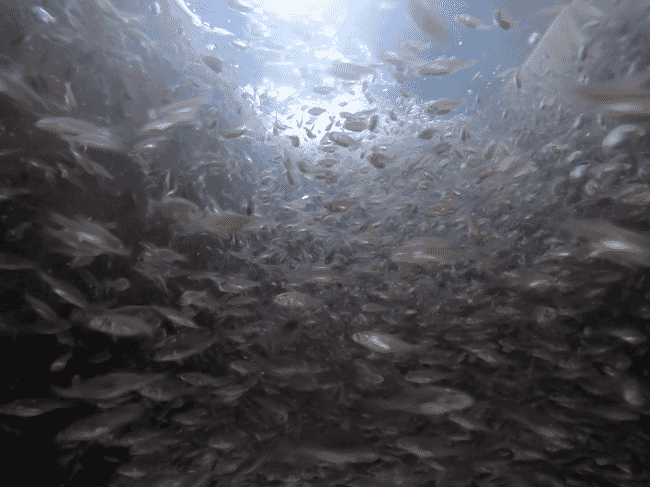
© Jimmie Garth, USFWS
When pressed about price points, Herbst knows the numbers, explaining: “Striped bass grown in North Carolina sell at retail markets in Raleigh for $23/pound ($50.60/kg) for skin-on fillets. Similar high-end retail markets are available throughout larger population centers in the US. It’s a question of establishing the supply chain. It may be possible to get to commodity scale one day, but crossing the expansive void between high-end retail and commodity markets is challenging.
“Our growers need to get ~ $5/lb ($11/kg) for whole fish at the farm gate. Wild-caught product drives prices down in spring and summer, with ex-vessel sales in Maryland ranging from $2.50 to $3.50/pound ($5.50 to $7.70/kg) this year. It’s hard to compete with that, but we have a premium product and year-round availability.”
Apart from research and educational activities, StriperHub is advancing the industry by supplying their improved lines of fish to commercial collaborators.
“We’ve supplied Striped bass fry and fingerlings to commercial farms in North Carolina, Maryland, South Carolina, Arkansas, Oklahoma and Texas, and we’ll add Florida this year,” noted Herbst.
The takeaway
The results of three decades of progress in striped bass selection and breeding at PAFL are an important testament to what can be accomplished with enough time, vision and financial support from institutions and agencies that understand the potential of genetic improvement in aquaculture.


